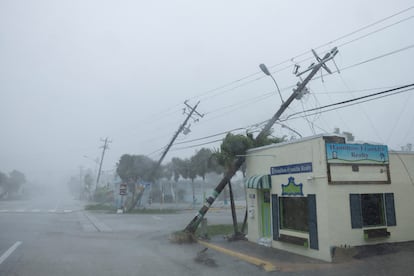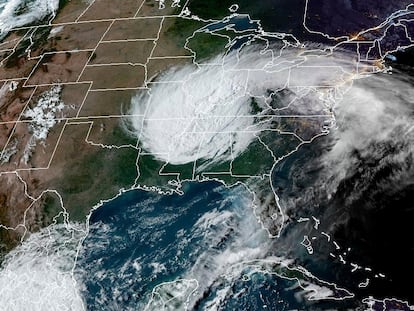US braces for devastation from Milton, which Biden calls the ‘storm of the century’
The hurricane is expected to make landfall in the next few hours in the Tampa Bay region of Florida. Kamala Harris urged residents to take the danger seriously: ‘This time it will be different’


U.S. President Joe Biden on Wednesday described Hurricane Milton as “the storm of the century,” a monster of wind and rain that, as it approached the western coast of Florida, gained and subsequently lost category 5 status, the highest issued by the National Hurricane Center (NHC). Biden spoke after noon at the White House, from where he led an extraordinary crisis management meeting that was broadcast by the news networks and also attended by Vice President Kamala Harris and members of the administration including Secretary of Homeland Security Alejandro Mayorkas.
When she took the floor, Harris delivered an address “in particular to the people of the Tampa region,” where the eye of the hurricane is expected to make landfall on Wednesday as early as 11 p.m. local time (5:00 a.m. CET Thursday). “We urge you to take this storm seriously. This is a storm that is expected to be of historic proportion. Many of you I know are tough and you’ve ridden out these storms before, but this one is going to be different. It’s more dangerous, more deadly, and more catastrophic. If you are told to evacuate, please evacuate immediately, do not wait until it’s too late.” Fifty-one of the 67 counties in Florida were on alert at that time, and mandatory evacuation orders had been issued in 15 of them.
The unusual staging also allowed for a political interpretation. There are fewer than four weeks left until the elections, and a slip-up in the federal government’s management of an emergency situation such as Milton could prove damaging at the polls. Also on the table is the controversy, fueled by the Republican Party, over the tasks of mitigating the destruction caused by the passage of Hurricane Helene just two weeks ago, the deadliest in the U.S. since Katrina in 2005.
The White House has expressed concern about the “outright lies” regarding the recovery efforts after Helene that former President Donald Trump and his allies have spread, with apparent electoral ends. Transparency in preparations for the new crisis can be interpreted as a strategy to silence such criticism (often based on hoaxes, in the case of Helene) before it occurs.
Milton’s fearsome path had veered slightly southward by Wednesday morning, as tens of thousands of residents along the Gulf Coast and in central Florida followed the advice of authorities on congested roads and left their homes behind in search of shelter, or prepared to meet the storm’s onslaught as safely as possible by boarding up their windows, filling up their cars despite the lines at gas stations, or stocking up on sandbags. At the start of the day, before the hurricane’s arrival, it was predicted, though not guaranteed, that it would make landfall in the Sarasota area, and not, as had been assumed, near the large coastal conurbation of Tampa Bay and St. Petersburg. As Biden recalled, the storm is expected to hit areas that have not yet recovered from the passage of Helene.
Storm surge
The storm was expected to arrive late Wednesday or early Thursday, but that timeline too is shifting as weather data is studied. Meteorologists estimate that by the time Milton makes landfall it will have doubled in size and will be a Category 3 or 4 storm. In the area that will be hit first, authorities are bracing for a storm surge of up to 15 feet (4.5 meters) high and winds of around 130 mph (210 kmph).
“Milton has the potential to be one of the most destructive hurricanes ever recorded in central-western Florida,” a spokesman for the NHC warned Wednesday. When one of these meteorological phenomena approaches, authorities prefer to err on the side of caution rather than give the false impression to residents of the affected areas that they can rely on their experience and ignore evacuation orders.
On Tuesday, Jane Castor, the mayor of Tampa, a city of 400,000 inhabitants, went even further: “I can say without any dramatization whatsoever: If you choose to stay in one of those evacuation areas, you’re going to die,” she told CNN.
In a public appearance Wednesday afternoon, Castor called the storm surge expected in Tampa — “twice the amount of Helene,” she warned — “historic, not just in terms of Florida, but the entire nation.” “We’re getting very, very close to the point where people will not be able to get out,” Castor told reporters, warning that Tampa’s major bridges would close in the afternoon. Earlier, Florida Governor Ron DeSantis had said in an early news update that regardless of where the eye of the storm makes landfall, the impact will be “broader.” “Absolutely every place on the west coast of Florida could experience a major storm surge,” he added.
The exposed Tampa Bay region has not suffered a direct hit from a major hurricane since 1921, which would explain its expansion over that time to become the densely populated hub it is today. In 2022, it was spared at the last minute by Hurricane Ian, which moved south and left about 150 people dead in Florida; it entered through the Fort Myers area (which is also in the probable path of Milton) and left a trail of destruction from the southwest to the northeast until it exited through the historic town of Saint Augustine, the first Spanish settlement in the United States. In its wake, Ian caused flooding in towns and cities in the interior, as well as further proof that in this type of phenomenon, water is often as fearsome, or more so, than the winds.
Unlike Ian, Milton will hit Florida on a perpendicular path, which provides hope that it will not cause as much destruction, but also fears that it will hit harder.
Sign up for our weekly newsletter to get more English-language news coverage from EL PAÍS USA Edition
Tu suscripción se está usando en otro dispositivo
¿Quieres añadir otro usuario a tu suscripción?
Si continúas leyendo en este dispositivo, no se podrá leer en el otro.
FlechaTu suscripción se está usando en otro dispositivo y solo puedes acceder a EL PAÍS desde un dispositivo a la vez.
Si quieres compartir tu cuenta, cambia tu suscripción a la modalidad Premium, así podrás añadir otro usuario. Cada uno accederá con su propia cuenta de email, lo que os permitirá personalizar vuestra experiencia en EL PAÍS.
¿Tienes una suscripción de empresa? Accede aquí para contratar más cuentas.
En el caso de no saber quién está usando tu cuenta, te recomendamos cambiar tu contraseña aquí.
Si decides continuar compartiendo tu cuenta, este mensaje se mostrará en tu dispositivo y en el de la otra persona que está usando tu cuenta de forma indefinida, afectando a tu experiencia de lectura. Puedes consultar aquí los términos y condiciones de la suscripción digital.
More information
Archived In
Últimas noticias
Most viewed
- Sinaloa Cartel war is taking its toll on Los Chapitos
- Oona Chaplin: ‘I told James Cameron that I was living in a treehouse and starting a permaculture project with a friend’
- Reinhard Genzel, Nobel laureate in physics: ‘One-minute videos will never give you the truth’
- Why the price of coffee has skyrocketed: from Brazilian plantations to specialty coffee houses
- Silver prices are going crazy: This is what’s fueling the rally










































